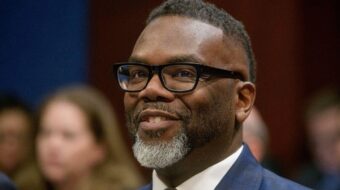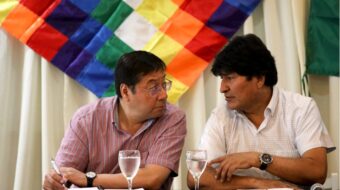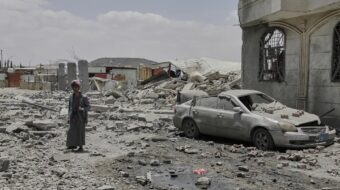
My November trip to Vietnam (PWW 1/21-27) was preceded by a fascinating visit to Korea, giving me a glimpse of the two countries that the U.S. has done most to devastate.
I was also drawn to Korea by personal ties. My father duly reported to Hamilton Air Field for induction to fight in the Korean War, but my birth gave him the fourth dependent necessary to decline service. As a young leftist, my intellectual mentor was a brilliant Korean émigré, Harry Chang.
And, since the 1980s, many of my Asian American activist colleagues in groups like CAAAV-Organizing Asian Communities in New York, Asian Immigrant Women Advocates in Oakland and the Korean Immigrant Workers Association in Los Angeles have their roots in Korea.
Despite these ties, I had little knowledge of the country before I began my trip preparation. But I quickly learned that Korea is one of the most politically unique countries on earth.
Not only has it stood as a divided country at the front lines of international conflict for more than 60 years, but its southern half is also the only former colony ever to become a fully developed capitalist country.
It also has powerful democratic and working-class movements. I happened to be in Seoul during the Korean Workers Day rallies on Nov. 11 that marked the 15th anniversary of the militant Korean Confederation of Trade Unions. I was privileged to meet with many activists of this vibrant movement during my short stay.
A ‘virtual holocaust’
One of the premier sites in Seoul is the Gyeongbokgung, a magnificent palace built at the apex of the Joseon dynasty some 500 years ago. A classic imperial walled city, it once boasted 800 buildings and over 200 gates.
Yet I was struck by the relative absence of the ancient structures that grace other Asian countries. Most of the Gyeonbokgung and other Korean palaces and temples are recent reconstructions, not originals.
The reason is that, according to Gen. Curtis LeMay, U.S. architect of the Korean War of 1950 to 1953, “we burned down every town in North Korea and South Korea, too.”
Historian Bruce Cumings describes the war as a “virtual holocaust” in which the U.S. cold-bloodedly caused the death of hundreds of thousands and destroyed practically every town and village in the country in order to defeat a resistance that was deeply rooted among the people, north and south.
It was in this brutal war that the U.S. military coined the infamous racist term “gook” to dehumanize Koreans and Chinese (and later Vietnamese) and justify their indiscriminate murder. At tragedy’s end the country remained divided. Today the tensions and problems remain, concentrated in the dangerous nuclear standoff between the U.S. and North Korea.
Rising from the ashes
Fifty years later, shiny modern buildings dominate Seoul, a bustling city that exhibits all the trappings of modern capitalism laced with the exquisite culture and gastronomic delights of traditional Korea. Literally from the ashes, South Korea’s 48 million people have miraculously built the world’s 11th largest economy.
But Seoul’s landscape is marred by the ubiquitous presence of police who I found ensconced in certain areas of the capital. This seemed a jarring contradiction to the incredibly civic-minded and kind demeanor of South Korea’s denizens.
Activists told me that South Korea actually has little crime. The police presence, they say, is not only a hangover of the past dictatorships but also reflects fierce fights over the continued presence of 30,000 U.S. troops and present-day class struggles.
Indeed, South Korea’s astonishing economic pace was accomplished under the iron fist of a U.S.-backed military dictatorship. But President Park Chung-Hee was a neocolonial ruler of a new type.
Park was a career military officer trained by the Japanese. However, after he staged a coup in 1961, he defied U.S. attempts to tether the South Korean economy to Japan and was determined to build Korean national strength.
He drew up Soviet-style five-year economic plans that concentrated the immense aid provided by the U.S. to this strategic country in the hands of a few huge Korean capitalists (known as chaebol). Park crushed all dissent in his ruthless march to monopoly capitalism until he was assassinated in 1979.
According to sociologist Hagen Koo, by 1985 the 10 largest chaebol groups accounted for an astonishing 30 percent of national sales and 12 percent of total employment. South Korea experienced “in one generation the same magnitude of change that took a whole century in European societies.”
Powerful workers’ movement
Joon S. Park, a political prisoner for 10 years and now a professor and peace activist, told me that after the war the dictatorship denounced even the mildest dissent as communist and traitorous.
But by the 1970s worker actions began to pick up, with courageous young women workers taking the lead. The historic Kwangju uprising of 1980 signaled the development of a massive cross-class democratic movement that ended the military dictatorship in 1987. And the successful general strike called by the Korean Confederation of Trade Unions (KCTU) in 1997 dramatized the independent political role of the working class in South Korean life.
This year the KCTU celebrated Korean Workers Day with an outdoor cultural event on a chilly Saturday night and a massive rally in the center of Seoul on Sunday afternoon, Nov. 13. Militant movement song and dance highlighted Saturday’s festivities, although much of the crowd holed up in the delectable tent eateries set up on the perimeter of the grounds.
I was moved by a powerful photo exhibit of the dozens of Koreans who gave their lives in the workers’ struggle.
Colorful flags and fierce sloganeering filled the air on Sunday, as about 70,000 Koreans thronged to the rally in the Gwanghwamun section of central Seoul. I walked the length of the rally and was taken aback that men constituted at least 90 percent of the crowd. A sizable contingent of trade unionists from Japan joined in spirited solidarity.
A huge phalanx of battle-ready police was deployed to the scene, but the event proceeded peacefully.
Above the speeches, Kim Myoung Joon of MediAct explained to me that the workers’ movement faces critical challenges today. Above all, he and other activists say, the state and the chaebol have reduced the majority of South Korean workers to temporary status in a bold move to reduce the cost of labor and divide the movement.
Aelim Yun of Korean Solidarity Against Precarious Work told me that officially 52 percent of all workers are temporary employees, but she believes the number is closer to 70 percent. She pointed out that the KCTU is mostly made up of permanent male workers and that it has been unable and/or unwilling to forthrightly fight for the temporary workers, many of whom are women.
Indeed, at the Saturday night cultural event dissident unionists set up their own stage within 50 yards of the official one to dramatize their displeasure with the KCTU’s handling of the temporary worker issue.
As I imbibed a delicious short rib soup, a bevy of activists informed me that another strategic division on the Korean left is between those who see reunification of the country as the primary task and those who emphasize the popular democratic and class fights within South Korea. This difference also reflects diverging attitudes toward North Korea.
In short, the activists I spoke to were sober that the South Korean labor and left movements confront complicated issues and a powerful class opponent — not to speak of the U.S. military — as they face the future.
In praise of peace at the DMZ
I also toured the notorious Demilitarized Zone on the 38th Parallel that separates the North and South. For decades the DMZ was one of the tensest military frontiers in the world, including a nuclear trip wire with virulent accusations and sometimes bullets zinging back and forth.
I was surprised to find the atmosphere in the DMZ much changed. Instead of fierce war propaganda, visitors are showered with paeans for peace. South Korean President Kim Dae-Jung, elected in 1998, won a Nobel Prize for his so-called “sunshine policy” that helped lead to the historic North-South Joint Declaration of 2000.
Since then South Koreans have erected numerous statues and memorials for peace and reunification in the Zone. They have even built an impressive new train depot that they hope will soon become a busy way station to the North.
Indeed, one of the most important accomplishments of the great democratic movement in South Korea has been the dissipation of the formerly violent anticommunist, anti-North Korean attitudes and policies.
Today even most of the leaders of the chaebol, with at least one eye on economic expansion, want better relations with the North and give lip service to reunification. Public opinion polls show that few South Koreans fear renewed war.
Similarly, in the heated international negotiations over North Korea’s nuclear program, South Korea has rejected Washington’s hard-line approach and worked closely with China for a more reasonable solution.
It seems that South Korea is coming to see itself as a part of the “Asian century” and not as a simple appendage of U.S. foreign policy.
Bob Wing is an Oakland-based writer and activist who visited Vietnam and Korea in November 2005. His essay on Vietnam appeared in the Jan. 21-27 issue of the PWW.









